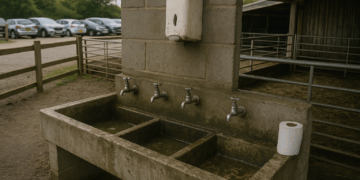Story Highlight
– UK temperatures set to drop significantly next week.
– Office conditions may be too hot or cold.
– Minimum recommended temperatures are 16C or 13C.
– Employers must ensure comfortable workplace temperatures.
– Snow and wintry conditions expected across the UK.
Full Story
As the UK braces for a significant dip in temperatures next week, office workers may find themselves facing a challenging shift in workplace conditions, with the potential for snow and severe weather anticipated. While those working remotely might avoid the complications posed by travel and colder temperatures, employees in physical offices are bracing themselves for possible disruptions to their daily routines.
The Meteorological Office has issued warnings regarding an impending drop in temperatures, with snow forecast in various parts of the country. This shift marks a notable change, especially for individuals commuting to work, who may experience traffic delays and adverse conditions during their journeys.
Office environments can fluctuate dramatically in temperature, often creating discomfort among staff. Guidance from the UK government outlines that indoor workplaces must maintain reasonable temperatures, though there is no law mandating specific minimum or maximum limits. Recommendations advise that indoor temperatures should not fall below 16°C, or 13°C if workers are engaged in physical activity. Unlike these guidelines for lower temperatures, there are currently no set maximum temperature limits specified by the government.
Employers are held accountable under health and safety regulations to ensure that workplace environments are not only comfortable but also properly ventilated. It is essential for employees who find their work environment uncomfortably cold or hot to report their concerns to their supervisors. Communication can often lead to assessments and subsequent adjustments, fostering a healthier workplace where conditions are monitored effectively.
The Workplace (Health, Safety and Welfare) Regulations outline the responsibilities employers have concerning workplace temperature. In the case of outdoor work environments, measures must be implemented to shield employees from harsh weather conditions, and rest facilities should maintain an appropriate level of warmth.
The Health and Safety Executive (HSE) has provided comprehensive advice on maintaining comfort in colder conditions. To combat low temperatures, employers are encouraged to adopt a range of strategies:
1. Use portable heaters to provide additional warmth in occupied workspaces.
2. Design workflow processes to limit exposure to colder areas or materials.
3. Reduce draughts, ensuring adequate ventilation still exists.
4. Implement insulating flooring or provide appropriate footwear for employees who work in cold conditions for extended periods.
5. Supply suitable clothing to protect staff in chilly environments.
Employers are alerted to the need for reassessment if employees report discomfort or health concerns related to temperature extremes. The responsibility lies with employers to evaluate and mitigate any risks presented by workplace conditions. Additionally, employees should feel empowered to reach out to their managers, union representatives, or workplace advocates concerning temperature-related issues.
In light of the forecast for next week, the Met Office indicates that the UK should prepare for a transition to noticeably colder air. This pattern is expected to lead to increased chances of snowfall as the week progresses.
In the early part of the week, particularly on Wednesday and Thursday, forecasted weather may include sporadic wintry showers primarily over the Scottish hills. However, predictions for Friday suggest that areas in the south might experience wet weather that could evolve into wintry conditions in the hilly regions of northwest Wales.
By the weekend, forecasts indicate a substantial shift toward colder air spreading across the UK. By Sunday and Monday, northern Scotland may witness not only sleet but possibly snow as the chilly air settles. Furthermore, this potential for winter weather is expected to extend into Northern Ireland, northern England, and North Wales by Tuesday.
In preparation for such weather, it is vital for employers and employees alike to engage in proactive dialogue about workplace conditions. Ensuring a comfortable indoor temperature can significantly enhance productivity and reduce health risks associated with uncomfortable working environments. Workers are encouraged to monitor their surroundings and voice any concerns, thereby collaborating with employers to maintain a conducive and supportive workplace atmosphere amid the changing weather conditions.
As part of a broader conversation about workplace safety and comfort, the efforts of employers to create an optimal working environment can make a substantial difference during periods of extreme weather. The forthcoming colder conditions serve as a reminder of the challenges posed by outdoor temperatures and the related duty of care expected from employers to protect their staff. Proper temperature management not only complies with legal obligations but also cultivates a more engaged and healthy workforce ready to thrive, regardless of the challenges that come with the changing seasons.
Our Thoughts
To avoid the discomfort caused by fluctuating temperatures in workplaces, employers must proactively assess and manage indoor climate conditions in accordance with the Workplace (Health, Safety and Welfare) Regulations. Key safety lessons include adhering to the suggested minimum temperatures of 16°C (or 13°C for physical work) to ensure a reasonable indoor environment.
Employers breached regulations by failing to provide adequate heating and ventilation measures, particularly in light of impending colder weather conditions. There should have been a contingency plan in place for maintaining a comfortable working environment, such as portable heating solutions and protective clothing for employees working in colder conditions.
To prevent similar incidents, employers should regularly consult with employees regarding temperature comfort and implement effective risk assessments tailored to their workplace. Establishing a clear communication channel for workers to report temperature-related issues and acting promptly on these concerns is essential. Adopting these practices would enhance compliance with health and safety legislation and improve overall workplace wellbeing.
































Employers should review heating systems and insulation now to maintain at least the recommended minimum temperatures, and assess any roles involving heavy physical effort where the lower threshold applies. Encourage staff to report uncomfortable conditions and consider temporary adjustments such as staggered tasks, additional breaks, or provision of warm clothing while longer term fixes are arranged. Document reports and actions taken to demonstrate compliance with health and safety responsibilities and to protect employee welfare.
Good employers will act now to check heating systems and give clear guidance on acceptable working temperatures. If staff feel too cold they should report it so adjustments or reasonable controls can be put in place quickly. Consider temporary measures such as extra clothing, localized heaters where safe, adjusted work patterns for physically demanding tasks and clear communication about expectations. Keeping records of concerns and actions helps demonstrate compliance and supports wellbeing.
Important reminder to review heating controls and ventilation to keep offices at safe working temperatures. Check which tasks might be classed as physically demanding and apply the 13°C threshold where appropriate. Where systems cannot maintain a comfortable temperature consider temporary measures such as portable heaters or adjusted break patterns and make sure risk assessments are updated. Encourage staff to report cold conditions early and record complaints so management can act promptly and demonstrate compliance.